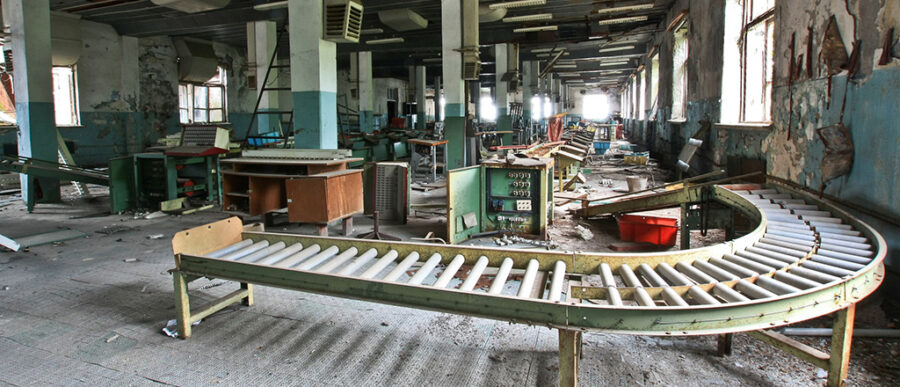They stole our jobs.
Plentiful, high-paying spots on assembly lines were once a powerhouse component in the employment mix in the U.S. President-elect Donald Trump’s campaign trafficked heavily in the idea that it’s time to wrest these jobs back to our shores and return the American worker to a dependable middle class existence. The message was met with eager ears, especially in parts of the traditional U.S. manufacturing base.
Now, as a Trump administration heads for the White House, will it be able to deliver on the promise to bring back these jobs? Just this week, air conditioner company Carrier announced that it had reached an agreement with Trump to keep 1,000 jobs in Indiana, where Vice President-elect Mike Pence is governor. If Trump pulls out of NAFTA, cancels U.S. participation in the Trans-Pacific Partnership or sparks a trade war with China and Mexico, will he be able to turn back the clock to the glory days of American manufacturing?
Actually, America makes more than ever. Still, Wharton management professor Ann Harrison says the plight of workers caught in a changing economy cannot be ignored. “If a manufacturing worker moves to work in the service sector, that worker’s wage actually does fall,” she notes. “Wages can fall 20%, so there is a wage premium attached to a manufacturing job. It is true that these jobs are in some sense good jobs, and I understand why a lot of workers hurt by trade would want their jobs back.” The sentiment is real, and some people have been hurt by trade, and that is why Trump’s message resonates with them, Harrison adds. “Having said that, the simple solution of trying to stop trade will not work — the ship has already sailed. So to try to bring those jobs back through tariffs is going to actually make things worse.”
No one “stole” America’s jobs, of course. Many companies moved them overseas, simultaneously increasing profits and reducing the price of products for the American consumer. Bringing back jobs would generally result in higher prices, which would have other implications for the economy as a whole. “The basic question is, why have these manufacturing jobs left the U.S., and what would be the real cost of bringing them back? And I think the answer is that it’s going to be very high,” says Wharton emeritus professor of management Stephen J. Kobrin. “Some surveys say some people are willing to pay more for products that are in made in the U.S. But how much more — 5%, 10%?”
“Some surveys say some people are willing to pay more for products that are made in the U.S. But how much more — 5%, 10%?” –Stephen J. Kobrin
Trump has reversed course on any number of campaign promises since November’s election. He has, however, amplified calls for tariffs and other measures in recent weeks, saying he will issue an intent to withdraw from the Trans-Pacific Partnership “from day one,” and instead “negotiate fair bilateral trade deals that bring jobs and industry back.” These may be, of course, just starting points for putting new deals in place. Carrier’s recent decision to not move as many jobs out of the U.S. as it had once planned came after a highly publicized push from Trump — but it isn’t likely to change the dynamics of where manufacturing jobs go. And so, as it becomes increasingly clear to Trump and his team that the ability to “bring back jobs” is inextricably tied to the greater health of the U.S. economy — not to mention the balance of power in Asia – what will they do, and how will the millions who voted for him react?
“What happens when people realize they’ve been taken?” asks Kobrin, who is also publisher and executive editor of Wharton Digital Press. “When people realize that he can’t bring back jobs and that they are not better off than they were two years ago, how does he use it — who does he blame it on? Are people going to believe that he failed because of the basic structural conditions, or because of some dark force opposing him that needs to be overcome? I think that’s a serious issue.”
The Costs of Reshoring
The biggest reason Trump — or anyone else — can’t bring back jobs is because there is nowhere to bring them back from. They have been lost in large part to the success of efficiency. Manufacturing output in the U.S. was at an all-time high in 2015. Over the past three-and-a-half decades, manufacturers have shed more than seven million jobs while producing more stuff than ever.
U.S. manufacturing had gross output of $5.9 trillion in 2013, more than one-third of the U.S. GDP that year, according to the Economic Policy Institute (EPI). “Manufacturing is by far the most important sector of the U.S. economy in terms of total output and employment,” the EPI reported in The Manufacturing Footprint and the Importance of U.S. Manufacturing Jobs from 2015. The manufacturing sector supported approximately 17.1 million indirect jobs in the U.S., in addition to the 12 million persons directly employed in manufacturing, for a total of 29.1 million jobs — or more than one-fifth (21%) of total U.S. employment in 2013.
Still, the sector has lost millions of jobs, so where have they gone? “If you try to understand how so many jobs have disappeared, the answer that you come up with over and over again in the data is that it’s not trade that caused that — it’s primarily technology,” says Harrison. “Eighty percent of lost jobs were not replaced by workers in China, but by machines and automation. That is the first problem if you slap on tariffs. What you discover is that American companies are likely to replace the more expensive workers with machines.”
“Eighty percent of lost jobs [in the U.S.] were not replaced by workers in China, but by machines and automation.” –Ann Harrison
The other problem, Harrison points out, is that a lot of what the U.S. exports is dependent on a supply chain that uses components produced cheaply elsewhere. “So if we slap tariffs on Mexico and China, it will make our own manufacturing less competitive,” she says. Starting a trade war with Mexico, China or both would mean that “the most likely immediate consequence is that they are going to turn around and play the same game by putting tariffs on things we produce for the world, so Mexico would likely slap tariffs on our agricultural exports, which are massive, and China would put a tariff on highly sophisticated machinery. If that escalates you end up in a situation where the economy is worse off.”
It is also important to remember that jobs have been both gained and lost due to trade, says Wharton management professor Mauro Guillen, director of The Lauder Institute. “We have gained jobs thanks to NAFTA, jobs that were in Europe and Japan,” he notes. “In the 1990s, after NAFTA came into effect, companies like Toyota, Nissan, Mercedes and BMW established plants in Alabama, South Carolina, Tennessee and other states, for instance. Their suppliers also came. But jobs have also been lost.” Displaced workers must be helped with educational opportunities, he adds.
It’s ironic that anyone would be looking to emulate factory work in China at this moment, says Marshall L. Fisher, Wharton professor of operations, information and decisions. “In one of the debates, Trump said the U.S. GDP grew at 1% — and look at China, it’s 7%. But if you read [China’s] last five-year plan, it tells you what their game plan is, and it is to get rid of low-end manufacturing jobs, and instead get into design, branding, distribution and product innovation. China is trying to get rid of low-end manufacturing as a way to continue the prosperity that Trump lauds. China is getting rid of those jobs because they feel they can’t compete in manufacturing. Many companies are leaving China because China has become too expensive to produce there. They are moving to Vietnam.”
The quest for cheap labor has led manufacturers from New England to North Carolina, then Brazil and Taiwan, China and Vietnam, then Indonesia, Bangladesh and maybe next Ethiopia. Asks Fisher: “Do we want to be trying to get back the jobs that China is getting rid of? And if Chinese workers, with wages maybe one fifth of U.S. workers, are too pricey, how can we compete for those jobs? I don’t think anyone is advocating lowering U.S. wages by five times.”
And then there is the question of the unintended consequences that come when jobs are brought back. “GE Appliances invested a billion dollars to reshore a few years ago; they brought [production] back to Kentucky and negotiated with the unions and had great difficulty in getting people to work in the factory,” says Morris A. Cohen, professor of operations, information and decisions and co-director of Wharton’s Fishman-Davidson Center for Service and Operations Management. “They found the cost of supplies higher because in part they were coming from overseas, and at the end of the day they sold to a Chinese company.”
“If Chinese workers, with wages maybe one fifth of U.S. workers, are too pricey, how can we compete for those jobs? I don’t think anyone is advocating lowering U.S. wages by five times.” –Marshall L. Fisher
People in the U.S. no longer found a factory job to be attractive, Cohen noted. “When they started working in a factory they found it to be unpleasant work, and GE could not retain workers. They would quit the third day,” he says. “We also don’t educate people to be skilled craftsmen here in the way the German apprenticeship program trains people. It doesn’t have the same social acceptance it does there. We need to establish the value.”
The Future of Work
In any case, a trade war is not going to solve the problem, says Cohen. The bigger point is that “manufacturing has gone down [in the U.S.] and in every developed economy,” he notes. “We have service jobs, but they are not necessarily as well paying as manufacturing. So we have to figure out a way of having high-quality jobs.”
The solutions that ultimately last are those that make economic sense. “We have to find out what our competitive advantage is today. Not where it used to be — in terms of innovation, new business models and the use of automation. There are other places in the world that are trying to leverage those same things.” People in Eastern Europe and South America are anxious to work and don’t need to be paid as much, Cohen notes, so the U.S. must find a way to compete. “I am not a pessimist, but the solution is not that we just bring back manufacturing to where it used to be,” he says. “I have great faith in our ability to innovate in this country, the flexibility of companies and the labor force, when properly incentivized. In the long run we can figure out how to be competitive.”
Globalization over the last several decades has brought enormous benefits to the U.S. and elsewhere — high-quality products and historically low prices. That raises the standard of living. “But there have been losers in this game,” says Cohen. “Some factories have shut down and people lost their jobs, so the benefits are not equally distributed. Some paid a heavy price, and it’s always been that way. Every country I’ve visited wants employment for workers, but at the same time wants low-cost products. It’s a balancing act, and it’s the role of government to set the relationship for their constituencies. We are competing in a very competitive world.”
“We have to find out … what our competitive advantage is today. Not where it used to be — in terms of innovation, new business models and the use of automation.” –Morris A. Cohen
Would Americans be willing to pay more for American-made goods? In general, no, not even if it meant paying just moderately more, according to an April Associated Press-GfK poll of 1,076 U.S adults. Confronted with a hypothetical choice between an $85 pair of pants made in the U.S. and a $50 pair made elsewhere, only 30% of respondents said they would opt for the U.S.-made pair.
Additionally, notes Kobrin, “there is a very real question — given tech and automation, can we realistically employ the entire working age population we have in the U.S.? We keep talking about creating new jobs and better jobs, but how many of those are there? The answer is, and always has been, we don’t know.”
American factories are now producing twice as much as they were in 1984, with one-third fewer workers, according to the Federal Reserve. Clearly this tension is playing out in the electorate, and the Democrats have not addressed and failed to help those hurt by globalization, says Harrison, co-author with Paris School of Economics professor Lionel Fontagné and others of the forthcoming book The Factory-Free Economy. And it’s not just Democrats with the tin ear. “People, academics like myself, are afraid to admit that there are losers,” she says, “and we haven’t addressed what to do about that. And I think that is a real failing. First, economists said there were no losers; then, they admitted there were and didn’t do anything about it. And that was a mistake the next administration was able to exploit in this whole election. Unless we deal with the losers in a constructive way to increase the opportunity, then we can’t globalize.”
Now, as the Trump administration raises the possibility of taking an ax to trade agreements and international relations, the future of manufacturing in the U.S. faces a crossroads in both substance and messaging that seems more perilous than ever. “The Trans-Pacific Partnership was an attempt to temper the influence of China, and by killing the TPP it strengthens China’s hand,” says Fisher. “It’s a really complex chess game. I would say a vision of restoring manufacturing in the U.S. is the wrong vision for lots of reasons, starting with the idea that somehow the greatness of a country is measured by the amount of smoke coming out of its smokestacks.”



